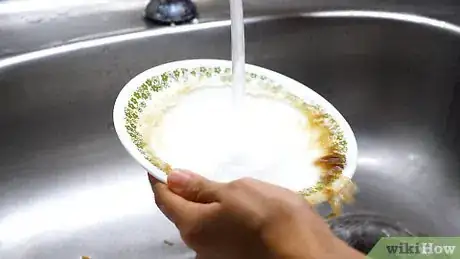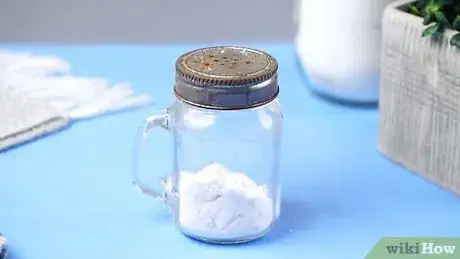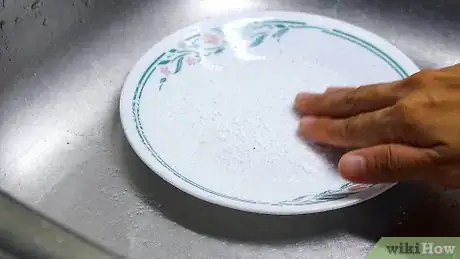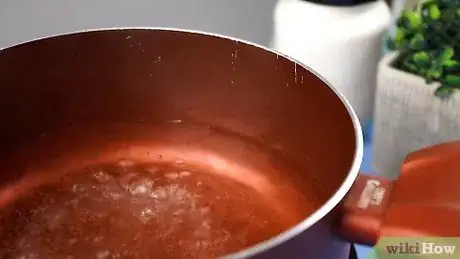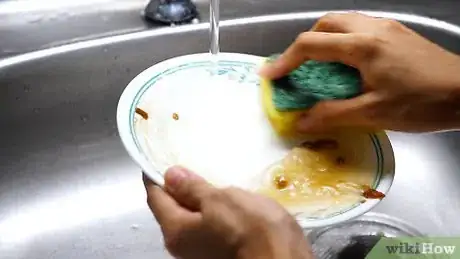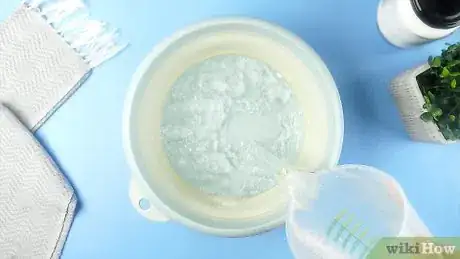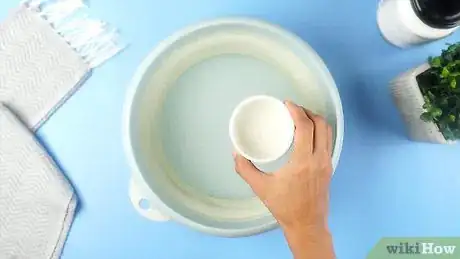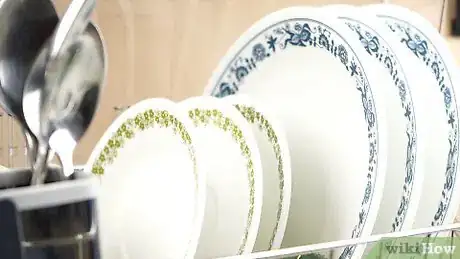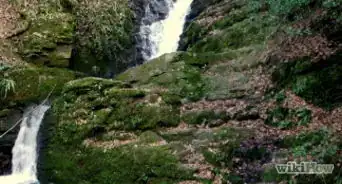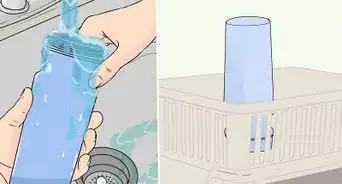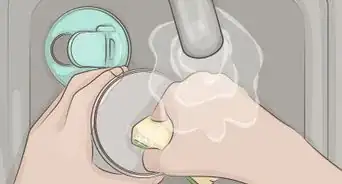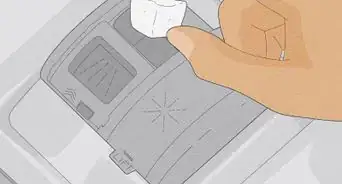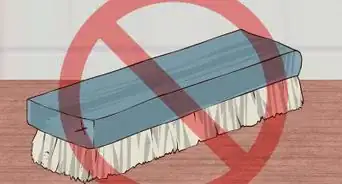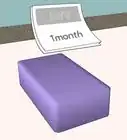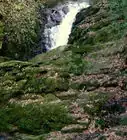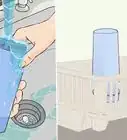This article was co-authored by Raymond Chiu. Raymond Chiu is the Director of Operations for MaidSailors.com, a residential and commercial cleaning service based in New York City that provides home and office cleaning services at affordable prices. He has a Bachelors in Business Administration and Management from Baruch College.
This article has been viewed 116,630 times.
It's hard to imagine washing dishes without soap and getting them clean enough to use again. But sometimes you find yourself without soap, either because you just ran out at home or because you're camping in the woods and didn't pack any. Using baking soda or campfire ashes are quick ways to get food and grease off your dishes without needing any soap.
Steps
Cleaning With Baking Soda
-
1Rinse excess food off your dishes. Hold the dishes under a running faucet or dip them in a basin of water. If necessary, use a sponge or scrubber to remove large bits of stuck-on food. Even if there's very little food residue left on them, you should still get them wet so that the baking soda has something to stick to.
-
2Fill a shaker with baking soda. Find an old parmesan cheese shaker or salt shaker and fill it with a generous amount of baking soda. Or make your own shaker by using a hammer and a nail to punch small holes into the lid of an empty jar.
- You can also opt to just use the box the baking soda came in, but be careful that you don't dump too much through the opening as you shake it.
- Label your new shaker to identify it as baking soda so that no one else thinks it's cheese, salt, or any other food.
Advertisement -
3Sprinkle baking soda onto your wet dishes. Shake enough onto the dishes so that when it combines with the water, it creates a paste. You may need to play with the amounts. If it seems too watery, add more baking soda. And if it seems too dry, add small amounts of water either with your fingers or with a teaspoon until you get the right consistency.[1]
-
4Rub the paste around on the dishes. Using either your fingers or a sponge, rub the paste around in small circles on the surface of the dish. Pay special attention to areas with stuck-on food. You may need to allow the baking soda paste to sit on stubborn food spots for a few minutes while it soaks in.
-
5Rinse the dishes. Wash the baking soda off either with running water or by dipping them into a clean basin of water. If the paste has begun to dry, you may need to use a sponge to rub it all off.
-
6Sterilize dishes that came into contact with raw meat. While the baking soda is able to get most dishes clean, it won't protect against bacterial hazards like raw meat. So be sure to sterilize the dishes that had raw meat on them before you use them again. Either wait until you have access to dish soap again or soak them in boiling water for 5-10 minutes.[2]
Using Wood Campfire Ashes
-
1Gather wood ashes from your campfire in a pot. Allow the ashes to cool before you attempt to handle them. Do not use any ashes that contain residue from plastic or trash that may have been burned, since these ashes could be toxic.[3]
-
2Heat some water in another pot over the fire. If it's from a natural source, allow the water to come to a boil first in case it's contaminated. Allow boiling water to cool before you attempt to wash the dishes, however, since it could splash on you and injure you.
-
3Scrub off excess food from the dishes. While you're waiting for the water to heat, use a sponge, a rag, or even a sturdy stick to remove large bits of food from the dishes. Don't worry about any grease left on the dishes since this will actually combine with the ashes to form a basic soap.
-
4Pour hot water into the pot with the ashes. Add the water slowly and gradually since you only want to add enough to create a paste. Stir it thoroughly with a stick and let it sit for a few minutes.
- While it's sitting, the hot water is dissolving potassium salts from the ashes to make a strong alkali solution. The alkali water will react with the fatty acids in the grease on your dishes to make soap.[4]
-
5Scrub your dishes with the ash paste. Do not touch the paste with your bare hands, since alkali water is extremely harsh on your skin. Wear gloves if possible, or use a stick or a scrubber with a handle to smear the paste all over your dishes.
-
6Rinse the dishes, the pot, and your hands in clean water. Do not rinse anything near a water source like a river or stream since you'll contaminate it with the ashes.[5] Instead, find a spot away from any bodies of water and rinse everything with the leftover boiled water, or boil more water and allow it to cool enough to handle.
Sanitizing With Chlorine Bleach
-
1Scrub off excess food pieces from your dishes. Use a sponge, scrubber, or rag to remove as much food as possible. Allow any dishes with stuck-on food to soak in warm water for 10-20 minutes so that the dishes have nothing on them when you put them in the bleach.
-
2Fill a bucket with cool water. Pour a gallon (about 3.75 liters) of water into the bucket, and be sure that it feels cold. Hot water will keep the bleach from sanitizing as it's supposed to.
-
3Add a tablespoon of unscented chlorine bleach. You can purchase this at many grocery stores or hardware stores. Be as precise as possible with your measurement so that the concentration stays at 1 tablespoon per gallon of water.
-
4Soak dishes in the solution. Allow each dish to soak for at least one minute in the bleach solution. You can add more time if you're worried about any lingering bacteria, especially if raw meat came into contact with the dishes.
-
5Remove dishes and allow them to air dry. Set them upright in a dish rack or upside down on a towel so that all the water can run off. Be sure they've dried completely before you put food on them again so that you're not ingesting any of the chlorine solution.
Expert Q&A
-
QuestionHow do you clean dishes naturally?
 James SearsJames Sears leads the customer happiness team at Neatly, a group of cleaning gurus based in Los Angeles and Orange County, California. James and the team have nine years of experience and offer green cleaning, interior and exterior window washing, and general apartment cleaning services. He provides transformative cleaning experiences by reducing clutter and renewing your home environment. James is a Trustee Scholar at the University of Southern California.
James SearsJames Sears leads the customer happiness team at Neatly, a group of cleaning gurus based in Los Angeles and Orange County, California. James and the team have nine years of experience and offer green cleaning, interior and exterior window washing, and general apartment cleaning services. He provides transformative cleaning experiences by reducing clutter and renewing your home environment. James is a Trustee Scholar at the University of Southern California.
House Cleaning Professional You can wash dishes with vinegar if you don't have any dish soap. If you're using a dishwasher, place a bowl of white vinegar on the top rack and run the machine like normal.
You can wash dishes with vinegar if you don't have any dish soap. If you're using a dishwasher, place a bowl of white vinegar on the top rack and run the machine like normal. -
QuestionHow can I make washing dishes easier?
 Community AnswerSoak your dishes in sink full of hot water and soap before washing so most of the dirt/gunk comes off. This makes them much easier to clean. Then leave them to air dry in a rack instead of drying them yourself.
Community AnswerSoak your dishes in sink full of hot water and soap before washing so most of the dirt/gunk comes off. This makes them much easier to clean. Then leave them to air dry in a rack instead of drying them yourself.
Warnings
- Use a fast moving stream to collect water, and avoid stagnant water which is more likely to contain parasites.⧼thumbs_response⧽
References
- ↑ https://www.passionatehomemaking.com/2008/03/kitchen-tip-washing-dishes-with-baking-soda.html
- ↑ https://www.reference.com/food/long-should-something-boiled-sterilize-68c73c6113b06cda#
- ↑ http://survivaltopics.com/clean-your-cooking-gear-with-wood-ashes/
- ↑ http://survivaltopics.com/clean-your-cooking-gear-with-wood-ashes/
- ↑ http://survivaltopics.com/clean-your-cooking-gear-with-wood-ashes/
